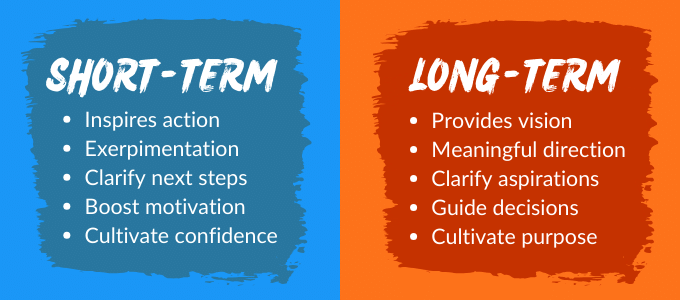Long-term goals provide direction and purpose in life.
But setting long-term goals the right way is essential for success. And the New Year’s resolution statistics show why:
Only 9% succeed in keeping their resolutions.
Do you want to become part of the few who do?
Learn how to set goals and keep reading this article for examples of long-term goals to inspire you to set your own.
Let’s dive in!
- Definition of a long-term goal
- Importance of long-term goals
- 7 Benefits of long-term goals
- Setting good long-term goals
- 67 Examples of long-term goals
- Secret to long-term goal success
- Tracking long-term goals
What is a long-term goal?
A long-term goal is an ambitious objective that takes at least a year to achieve – even up to several lifetimes. Popular types include life goals, yearly goals, 5-year goals, and 10-year goals.
A personal vision statement are also great to have – although they’re technically not goals. However, they do serve a similar purpose.
Some examples of long-term goals include:
- Become a full-time freelancer within 3 years.
- Travel to 100+ countries before 2050.
- Start your own business in 18 months.
What’s the key difference between long-term and short-term goals?

Long-term goals reflect your aspirations whereas short-term goals provide the actionable steps to achieve them.
But do you really need long-term goals?
Why are long-term goals important?
Long-term goals are important because they focus your efforts on what’s most meaningful to you. They provide direction and instill a sense of purpose, guiding your decisions and actions.
Without a long-term vision, you end up dabbling.
However, when you stack short-term achievements towards a long-term vision, you’ll experience more success and fulfillment.

In short, a long-term strategy is essential to maintain focus and direction toward your dreams and aspirations.
And here are the…
7 Benefits of long-term goals
Here’s what you can expect when setting long-term goals:
- A clear direction: Aspirational targets channel your efforts into a focused direction, shielding you from shiny objects and distractions.
- A sense of purpose: Long-term goals reflect your most important objectives in life, providing meaning and joy.
- Personal growth: A bold vision requires you to learn new skills, gain knowledge, and step outside of your comfort zone.
- Ongoing satisfaction: Achieving short-term goals in pursuit of a more significant goal ensures continuous progress and fulfillment.
- Leave your legacy: The greatest aspirations often make a lasting impact on the lives of others, such as a personal mission statement.
- More resilience: A long timeframe instills a sense of patience and hope, enabling you to overcome setbacks.
- They offer guidance: Long-term objectives form a framework for prioritization, making them excellent tools for time management and decision-making.
In essence, long-term targets provide a framework for purposeful living, continuous self-improvement, and success.
But you’ll only reap those benefits if you learn…
How to set good long-term goals?
The purpose of long-term goals is to identify a clear direction so you can live with intention.
And while long-term goals are aspirational, they should still follow the SMART goal-setting framework – with a few adjustments.
Do you feel lost?
Take this free personality test to uncover your personal blueprint for success and happiness. Within minutes, you gain insights into your personality and strengths, allowing you to set better goals, experience more joy, and feel fulfilled.
Unlock your inner secrets today
SMART long-term goals
SMART stands for Specific, Measurable, Achievable, Relevant, and Timely. And here’s how this framework applies to long-term goals:
- Be specific by stating exactly what you want to achieve. The more specific your goals, the easier it is to stay focused. For example, to travel to 50 countries is better than to travel the world.
- Make it measurable to keep track of your progress and stay motivated. Say you want to buy a house within 5 years. You can make it measurable by changing it to save $50K to buy a house within 5 years.
- Only set relevant goals that align with your values and interests. Because if they’re inauthentic or lack meaning, you’ll struggle to stay consistent. That may sound obvious. But it may surprise you how many people set irrelevant goals, including me when I was chasing a million dollars. In short, you’re more likely to succeed if you know WHY your goal is relevant – and feels authentic – to you.
- Achievable vs aspirational goals: The SMART framework states that your goals should be realistic and achievable. However, the longer your timeframe, the less important this idea becomes. After all, predicting long-term outcomes is challenging – and you want to avoid setting a ceiling too low for what you can achieve. While your yearly goals should feel somewhat achievable, your 10+ year goals can be wild and crazy.
- Set deadlines: Your goal remains merely a wish without a deadline. So decide on a timeframe. This creates clarity and helps you prioritize and plan your short-term goals.

What else do you need to know for…
Long-term goal success
Setting good long-term goals is the first step – and pursuing them provides meaning and joy.
It makes life worth living.
But while setting long-term goals provides a motivational sugar rush, it never lasts.
A few months – at best.
And that’s not enough to reach far-away goals…
You see, achieving long-term objectives takes a lot of time, effort, and dedication. And once the initial rush wears off, your ambitious goals can feel daunting or even demotivating.
The solution?
Make your aspirational targets achievable by setting short-term goals. These goals form the stepping stones that drive action, instill self-confidence, and provide several victories that fuel momentum.
Combine the two for continuous success and fulfillment.

With that said, let’s look at…
67 Long-term goal examples
The only long-term goals that matter are those most meaningful to you.
That’s why I recommend you skim through the list below and use the long-term goal examples to generate ideas. Then, set your life goals.
There’s no good or bad approach.
What matters is that you find something that inspires YOU.
Let’s dig in for inspiration.
Long-term personal goals
- Read: Read 100 self-improvement books in 24 months.
- Study: Complete a master’s program in the next 5 years.
- Language: Speak a new language fluently within 2 years.
- Meditation: Meditate for 200 hours this year.
- Gratitude: Write a daily gratitude note and add it to a gratitude jar. Review your notes every month for an entire year.
- Creativity: Spend one day per week working on a personal creative project for the next 5 years.
- Experiment: Try a new activity every month for the next 3 years.
- Self-reflect: Journal for 30 minutes about your thoughts, goals, and experiences once a week for 100 weeks.
- Goal-setting: Set monthly goals at the beginning of each month – and commit to this process for 36 months.
- Music: Practice any instrument for 200 hours this year.
- Skills: Master your favorite skill by practicing it for 10,000 hours in the next 25 years.
- Write: Create 500 posts for your blog this decade.
- Travel: Explore 50 different countries in the next 25 years.
- Relax: Take a 1-month sabbatical this year.
- Contribution: Volunteer for 50 hours each year.
Long-term career and business goals
- Career plan: Develop a comprehensive 5-year plan and set yearly career goals to help you achieve it.
- Network: Triple your LinkedIn network within 2 years.
- Events: Take part in 12 industry events and write email summaries for your colleagues over the next 36 months.
- Coach: Invest in your career or business with a monthly coaching session for 30 months.
- Productivity: Do twice as much by spending only 50% of your current time expenditure within 3 years.
- Focus: Try deep work strategies for 12 months.
- Prioritization: Spend the first 2 hours of each day on your most important and meaningful task for the next 18 months.
- High-income skill: Practice a high-income skill for at least 2 hours per day for 2 years.
- Certification: Achieve an advanced industry certificate this year.
- Dream job: Engage with people who are connected to your dream career for at least one hour per week for the next 2 years.
- Freelance: Earn $100K per year with your freelance business within 3 years.
- Side hustle: Earn $10,000 per month from your passion project by the end of 2030.
- Business: Start your dream business within 5 years.
- Personal brand: Share one valuable insight each week within your industry for the next 5 years.
- Present: Speak on [insert a popular industry event] in 5 years.
- Leadership: Create a plan to achieve a leadership position within the next 3 years – and stick to it.
- Performance: Identify the most important performance metrics at work and increase yours by 5% every month for 24 months.

Long-term fitness goals
- Health check: Check your blood annually to identify deficiencies.
- Alcohol: Limit your alcohol consumption to one glass of wine each week for 24 months.
- Weight-loss: Lose 20 pounds this year.
- Cook: Learn to cook 50 healthy recipes in 2 years.
- Intermittent fast: Try different fasting methods for a year.
- Consistency: Go to the gym 250 times this year.
- Walk: Hike 10,000 miles in the next 10 years.
- Run: Finish a marathon within 3 hours in the next 5 years.
- Dance: Master salsa by taking a weekly class for 2 years.
- Flexibility: Learn the middle split within 18 months.
- Calisthenics: Unlock a 5-second one-arm handstand in 5 years.
- Strength: Participate in a powerlifting competition in 2 years.
- Recovery: Take a one-week wellness retreat every year.
- Massage: Enjoy 52 massages this year.
- Experiment: Take a weekend or week-long workshop to learn the traits of a new sport like sailing or mountaineering this year.
Long-term relationships goals
- Connect: Visit each friend at least twice this year.
- Meet people: Go to 52 meetups to meet strangers this year.
- Family time: Plan a family holiday in the next 18 months.
- Shared meal: Go out for dinner with your partner, friends, or family twice a month this year.
- Date: Go on 100 dates this year (with strangers or your partner).
- Adventure: Go on a 3-month backpacking adventure with your partner or friend in the next 5 years.
- Confidence: Travel by yourself for 6 months within 3 years.
Long-term financial goals
- Net worth: Become a millionaire by age 40.
- Debt: Pay off your mortgage within 10 years.
- Retirement: Have a $1 million retirement fund by age 60.
- Save: Save $100,000 to start your business within 4 years.
- Emergency fund: Have a $20,000 backup fund in 3 years.
- Invest: Build a $1 million diversified investment portfolio with an annual return of 8% over the next 20 years.
- Income: Earn $100K a year within 5 years.
- Side gig: Earn $2,500 per month in passive income in 3 years.
- Frugality: Live on 80% of what you earn every year.
- Credit: Attain a credit score of 800+ within 5 years.
- Charity: Donate $10,000 to charity in the next 10 years.
- Fun: Spend 5% of your income on travel and holidays each year.
- Luxury: Pursue your dream car within 10 years.

The ultimate secret to long-term goal success
The most important part of a long-term goal is to understand why it’s important to you.
Although that may sound obvious, you’ll be surprised how many people set goals in pursuit of external validation, not personal fulfillment.
For example, becoming rich is a popular goal.
And I, too, had the goal to become a millionaire.
But it just didn’t inspire me enough for one simple reason: I lacked a strong reason WHY.
Why did I want to become a millionaire?
The answer seemed obvious to me: buy a luxury car, travel around the world, and take my parents on the best holidays.
But I couldn’t really care about the first two…
Even if I made billions, I’m not interested in driving the most luxurious cars. And a mansion with a gazillion rooms won’t feel much like a home to me.
Only the latter two reasons resonate with me.
Now, I’m far from a millionaire but I can already travel as a freelancer. And I don’t need a million dollars to take my parents on nice holidays.
In other words, I lacked a strong reason WHY to strive for a million.
No wonder I lacked the motivation to go after it…
Instead, what I learned is that I’m motivated by a sense of meaning, freedom, and autonomy.
And my long-term goals should reflect that.
So a better personal goal is to earn $100K per year, doing meaningful work that I can do from anywhere in the world.
What about you?
Do your goals reflect what’s truly meaningful to you?
Or do they reflect others’ definition of success?
Some food for thought.
How to track and stay consistent with long-term goals?
Measuring long-term goal progress helps you stay motivated. And reviewing them frequently keeps them top of mind.
Here are some ideas to try:
- Use a goal-tracking app to help you set and track long-term and short-term goals. Read my complete review of Goals on Track, the goal planning and tracking software I use every day.
- Get the best goal planner if you prefer a physical option to set and track your goals. Invest in a quality planner and pen to seal your commitment and make goal-setting a premium experience.
- Create a vision board with inspiring images, words, and quotes that represent your goals. Look at your vision board regularly to increase motivation and focus.
- Get an accountability buddy who’s pursuing their own goals. You can support each other to stay consistent. And most people perform better when they’re accountable to someone else.
- Join a support group. There are many support groups for people who are working on achieving their goals. Find a group online or in your local area for support and motivation.
- Track your progress regularly. When I set quarterly goals, I’ll reflect on all other goals too. And when I set monthly goals, I’ll reflect on my quarterly and yearly goals.
- Make adjustments as needed. Not everything will go to plan and your aspirations may change. For example, I realized some of my goals were for external validation, not because they truly inspired me. So I changed or removed them.
Tracking your long-term goals can be challenging, but it is worth it. By measuring your progress, you’ll stay on track to achieve your goals.

What’s next?
Long-term goals reflect your deepest aspirations, providing a clear direction and a sense of purpose. They act as a north star, guiding your decisions and actions.
And together with short-term objectives, they create a meaningful path for lasting success and fulfillment.
Key takeaways:
- Long-term objectives provide direction and purpose.
- Aspirational objectives ignite personal growth and fulfillment.
- The longer your timeframe, the less reasonable your goal has to be. And it’s okay if your greatest ambitions scare you a little bit.
- Set short-term goals to fuel progress on your larger ones.
Also read the ultimate goal-setting guide to understand how long-term goals fall into the bigger picture.
Further resources:
- View this list of the best books about goal-setting
- Course: Goal-Setting Mastery: 10X Your Results in 12 Months
- Tool: Goals on Track is the tool I use for all my goals. You can read my Goals on Track review to learn more about the tool.
Take action: Identify a long-term goal that resonates with you. Break it down into smaller, actionable steps. And start taking action.
Do you want to transform your life for good? Sign up below for weekly tips to achieve your goals and live a meaningful and fulfilling life!

